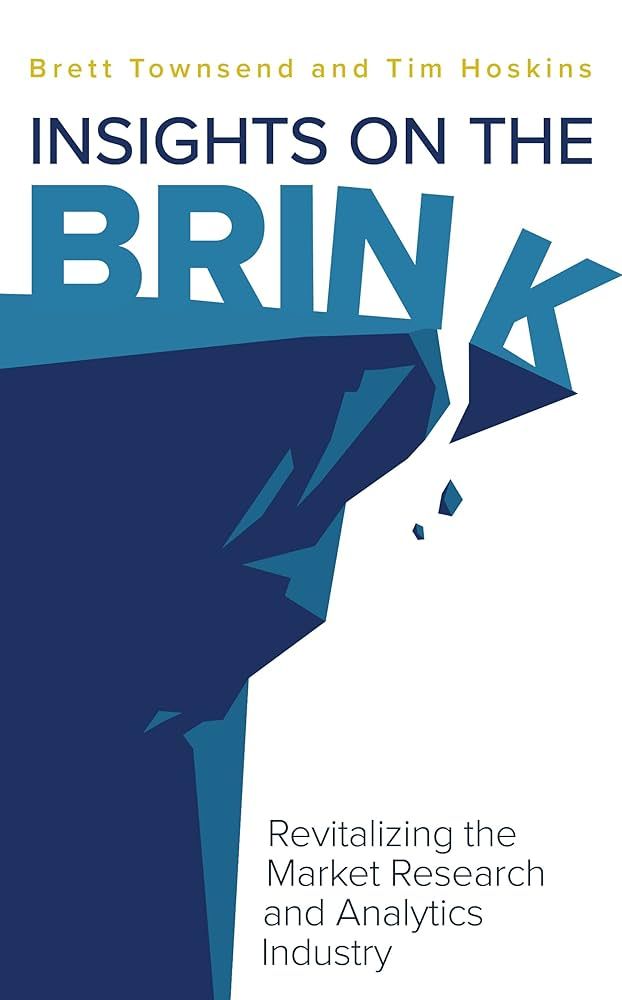Insights on the Brink: The book that’ll help turn your Insights work into working dollars
“Insights on the Brink” by Brett Townsend and Tim Hoskins encourages insights professionals to transform their work into revenue-generating assets, emphasizing the necessary shifts in mindset, organization, and skills to drive real business impact.

The Google Ngram curve for consumer insights shows how much has been published on this topic in the last 20 years. Some books that contribute to this curve are good. Some are great. But Brett Townsend and Tim Hoskins’ recent book Insights on the Brink exceeds great.
Because it’s exceptional. Exceptional in how it diagnoses the challenges consumers insights professionals face. Exceptional because it practically tells us how to fix them. And exceptional because it practices what it preaches when it comes to storytelling.

We’re on the brink
The death of insights. The death of marketing. The death of the CMO-style headlines is clickbait commonplace. But Brett and Tim frame the challenging situation Insights is in as follows:
Businesses split their marketing budgets into working (revenue generating) and non-working (non-revenue generating) dollars. And businesses see Insights as non-working dollars.
Ouch.
Most firms keep their working-to-non-working dollars ratio at 70:30. This means businesses are always going to cut insights budgets before they cut media or advertising ones.
Ouch. OUCH.
But why?
What’s bringing us down?
Brett and Tim highlight three main reasons Insights is in this position:
1. We’ve forgotten that our work must lead to sales. Insights exists solely to generate revenue whether it be by finding a target consumer. Co-creating a new product. Or understanding how to communicate it effectively in a way that drives sales.
2. We don’t talk enough about when we do generate revenue. If we’re involved in NPD and a business actions the research recommendations and the product sells, Insights is generating revenue. So why don’t we take our credit when it’s due?
3. We’ve become too comfortable in our roles as project managers and methodologists. This means we’re spending too long making sure projects run smoothly. And that research is following due process. Not thinking about how our work generates revenue.
How do we come back from the brink?
Brett and Tim identify the changes in attitude, organization and skills Insights Teams must make to overcome these three challenges.
Attitude
This starts with having the humility to reflect on the work we’re doing and asking: are we working on genuine business problems? Are we too wrapped-up in finding out ‘interesting things’ instead of generating revenue?
Organization
From this attitudinal change, organizational changes should arise. These include moving from being Centres of Excellence, sitting on archives of insights, to reducing research wastage and focussing solely of revenue generating work. This will involve learning the language of finance. Forging new internal relationships. Getting closer to sales. All of which sound uncomfortable. But vital given comfort is our issue.
Skills
But to create these organizational changes, we’re going to need new skills. Less focus on sampling and questionnaire design. Undifferentiated skills. Skills which AI will soon commoditize. We need to spend more time building relationships, instead of building decks. Which of course, leads to a reminder that we need to continue to improve our storytelling abilities.
Once upon a time, there was a researcher and a deck….
…and the researcher spent far too long loading their deck with charts and data. But then Brett and Tim came along and said:
“This isn’t the kind of deck we need. You need to spend more time thinking about the consumer conflict in your story. How our brand resolves the conflict. How your brand becomes the hero. And how this generates the company revenue.”
A key word in here is conflict. Brett and Tim highlight conflict’s role throughout their book. And they do so by showing where Insight Team’s face conflict. (And in doing so, highlight its role in storytelling). Some of these conflicts include:
· Academic vs. commercial research – a conflict between methodological perfection and getting ‘good enough’ evidence to inform decisions
· Using digital insight tools vs. going learning in the real world – a conflict between the dangers of viewing the world from a desk and the practicalities of spending time in-market
· Overinvesting time in creating presentations vs. creating unique decks for different audiences – a conflict between faster content creation and effective communication
Ironically, you – the reader – now find yourself in a conflict. Do you close this tab and go about your day? Or do you click on this link to buy Insights in the Brink (this article’s hero character) by Brett Townsend and Tim Hoskins? I’d suggest you do and help pull your Insights team back from the brink.
Jack Miles
Editor in Chief at Research WorldJack specialises in quantitative research for international clients across an array of sectors. These studies have led him to work with brands such as Jaguar, Navistar and Volvo. His main research interests are brand research and consumer trends, with a focus on quantitative methods and the use of statistics to derive solid strategic planning for clients.
He has a particular focus on developing creative ad-hoc quantitative methods that use a range of data sources. He can also be found writing papers for a range of well-known publications such as Admap, Huffington Post and Research World.
Outside the office, Jack can be found training in martial arts, in which he holds a 3rd degree black belt in Taekwon-do, and partaking in various endurance sports.


